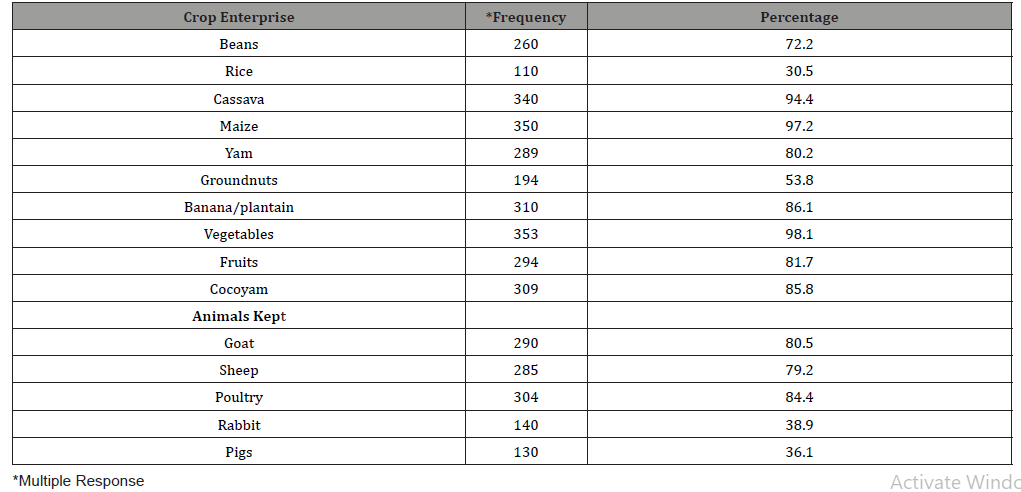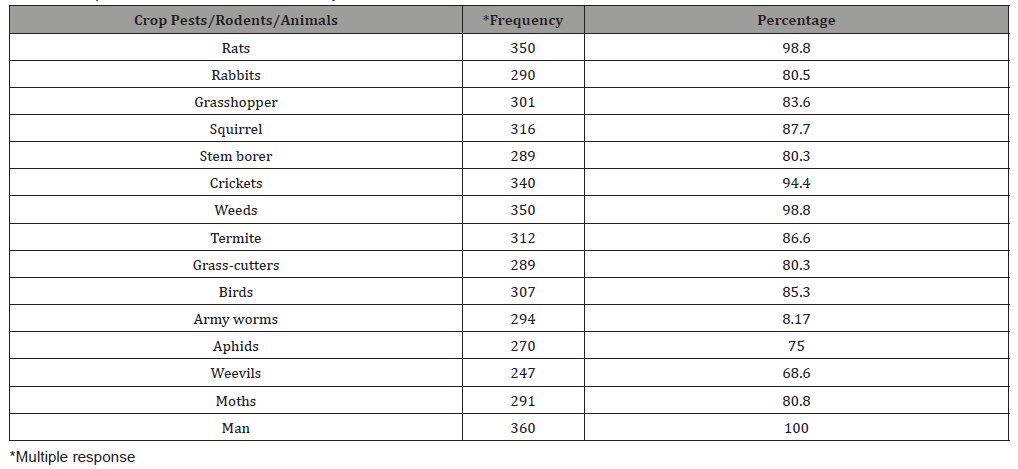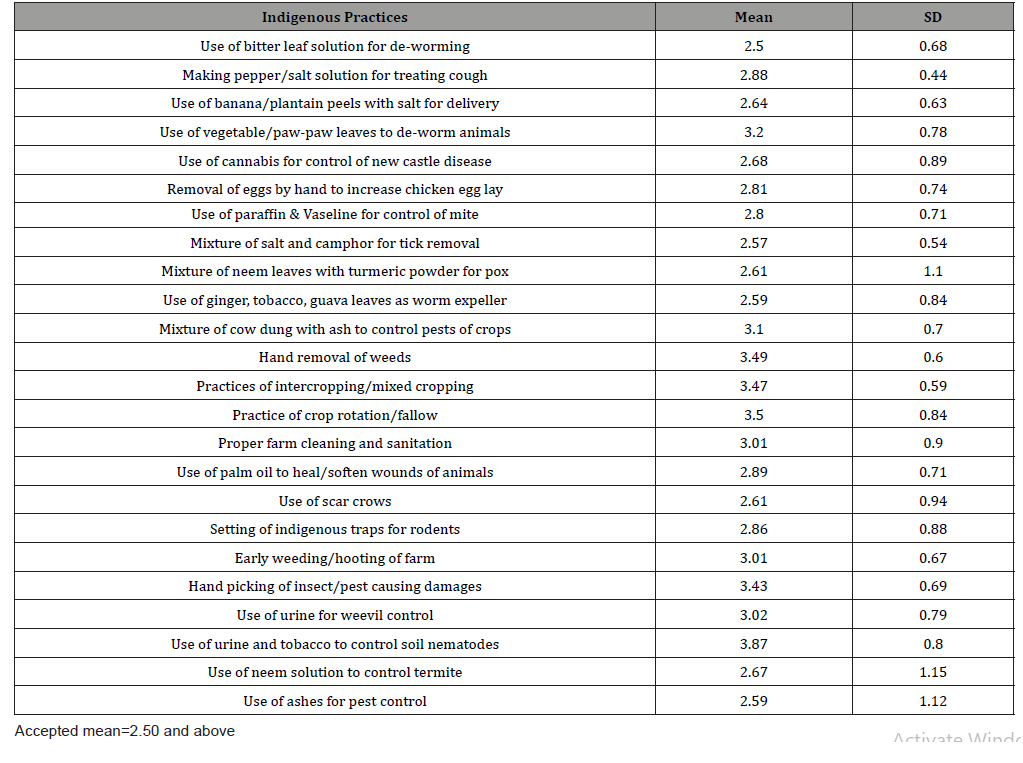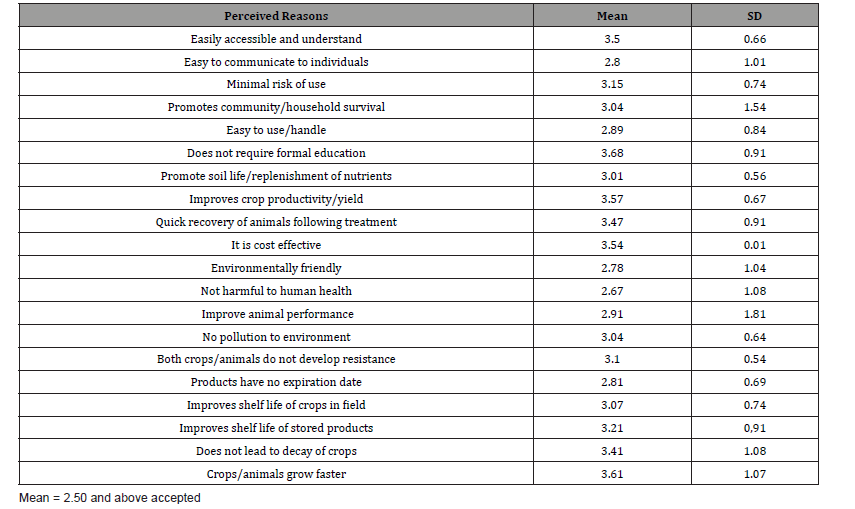 Research Article
Research Article
Women Farmers’ Perceived Reasons for Use of Indigenous Knowledge in Crop Pests and Animal Diseases/Disorder Management in Imo State Nigeria
Anyoha NO, Aja OO and Nwozuzu SO*
Department of Agricultural Extension, School of Agriculture & Agricultural Technology, Federal University of Technology, Owerri, Imo State, Nigeria
Nwozuzu SO, Department of Agricultural Extension, School of Agriculture & Agricultural Technology, Federal University of Technology, Owerri, Imo State, Nigeria.
Received Date: February 04, 2021; Published Date: January 19, 2021
Abstract
This study examined the reasons women farmers in Imo State have, for employing indigenous knowledge practices in management of crop pests and animal diseases. A total of 360 women farmers were randomly selected from the 3 agricultural zones of the State. Questionnaire and oral interview were used to elicit information from the respondents. Percentages, mean and standard deviation were used to analyze data obtained from the field. Results showed that the women farmers grow crops like cassava, maize, yam, vegetables among others. They rear goats, sheep, poultry birds and pigs. The crop pests in the area include rats, rabbits, squirrel, and weevils etc. While the animal diseases include coccidiosis, worms, fever, diarrhea, foot rot, new castle among others. Indigenous knowledge practices employed in treating crop pests and animal diseases include the use of bitter leaf solution to de-worm animals (M=2.50), early weeding (M=3.0), handpicking of insects (M=3.43) among other practices. The reasons for use of these practices include easily accessible and understood (M=3.01), no pollution to environment (M=30.4), fast growth of crops/animals (M=3.61) among many others. We recommend that indigenous knowledge practices be promoted and recommended to all framers who wish to adopt them.
Keywords: Indigenous knowledge; Crop pests; Animal; Diseases; Women; Farmers
Introduction
In Nigeria, individuals in rural communities especially women are endowed with indigenous knowledge of traditional medicine, land use and management, family healthcare, breeding of food crop species, preservation of seeds and the domestication and use of wild edible plants [1]. Women pivotal role in sustainable development in rural communities is evident in their contributions to the family and society at large as wives and mothers. They engage in production and marketing of foodstuff to enhance the local economy.
Women have been central to the production, processing and marketing of food. They are custodians of biodiversity and knowl edgeable in land use and management, child delivery, family planning and health care. Women’s contribution to the maintenance of the local economy is made possible through the use of their indigenous knowledge. In Tonkerere Village, Ife Central local Government (South West Nigeria) 86% of rural women are herb sellers, with the ability of detecting the medicinal value and viability of local herbs [2]. In India, rural women were able to identify no fewer than 145 species of trees and their uses, while forestry expert were familiar with only 25 species (Shiva and Dankelmann, 2006). This is a reflection of indigenous knowledge inherent in rural women. With the help of indigenous knowledge, women in Burkina Faso carefully collect the fruit, leaves and roots of native plants, like the bark baobab tree (Adansonia digitata), red sorrel leaves (Hibiscus saddarifai>) Kapok leaves (Ceiba pentandra) and tigernut tubers Cyperus esculentus L) for use in diet of their families, supplementing the agricultural grain [3].
There is no gainsaying the fact that women possess an enormous amount of knowledge about food production and processing, health, child rearing, breeding of food crop species, preservation of seeds and the domestication and use of wild edible plants. In the area of agriculture, rural women use their indigenous knowledge to raise agricultural productivity [4]. The rural woman is greatly endowed with the special knowledge with which activities are carried out and notable progress mode as a wife and mother, to ensure the survival of the family and the society at large. Their domestic activity essentially contributes to the maintenance of the local economy to enhance sustainable development. However, indigenous knowledge has not been properly mainstreamed into developments projects, especially in Nigeria [4,5].
Rural women also use their indigenous knowledge to improve their livelihoods and to develop survival strategies. In the area of agriculture -a domain of development, rural women use their indigenous knowledge to raise agricultural productivity. Indigenous knowledge has shown itself to be an important and effective resource in the life of rural people, not only in the areas of science, agriculture and medicine but also in other areas of rural development [6]. Rural women are pivotal to development in African countries as they play diverse roles in development projects and initiatives. They contribute to wage activities, engage in the marketing and distribution of foodstuffs, and ensure the survival of both the family and social unit. Specifically, their domestic activities make vital contributions to the maintenance of local economies. It is therefore important that Indigenous women, as custodians of knowledge about both biodiversity and land use and management, are recognized and encouraged to use their knowledge to enhance sustainable development [7,8].
The abysmal failure of non-traditional agricultural techniques in Africa has made it critically necessary for Africa’s agricultural policies to revert to its age-old Indigenous agricultural technologies. Indigenous knowledge has shown itself to be an important and effective resource in the life of rural Africa community, not only in the area of science, agriculture and medicine but also in the other areas, such as education, cultural affair etc. The rural woman is greatly endowed with the special knowledge with which activities are carried out and notable progress mode as a wife and mother, to ensure the survival of the family and the society at large [9]. Their domestic activity essentially contributes to the maintenance of the local economy to enhance sustainable development. However, indigenous knowledge has not been properly mainstreamed into developments projects, especially in Nigeria. Indigenous knowledge has not been given the rightful position in development initiatives and the reason for its use is not well documented in the study area. This necessitates the study. This study identifies the crops and animals grown and kept by the women, crop pests/animals causing disorder, animal diseases, indigenous management practices and the reason for continuous use of indigenous management practices.
Methodology
Imo State in Southeast, Nigeria is made up of three agricultural zones, namely, Orlu, Owerri and Okigwe Agricultural zones and twenty-seven local government areas. The estimated population of Imo state in 2020 was 5.8 million and the population density varies from 230 to 1400 people per square kilometer. The state has two distinct seasons, rainy and dry (harmattan) seasons. The rainy season commences in April and lasts until October with an annual rainfall varying from 1500mm to 2200mm (60 to 80). An average annual temperature above 20 °C creates an annual relative humidity of 75%, with humidity reaching 90% in the rainy season [10]. Purposive sampling technique was used to select 360 rural women farmers from a list of 3600 across the three Agricultural zones. That is 120 rural women farmers from each Agricultural zone, making a total of 360 rural women farmers. The two main sources of data collection used in this study were primary and secondary data. The primary data were collected from the field survey/investigation by administering questionnaire to the rural women farmers while the secondary data were utilized to provide background information that were necessary to achieve some objectives of the study. Tables and percentages were used to achieve objectives 1, 2 and 3. A four (4) point Likert type scale of Strongly Agreed, Agreed, Disagreed and Strongly Disagreed, assigned values of 4 to 1 respectively was used to achieve objectives 4 and 5 which is mathematically represented as
Therefore, a mean of 2.50 was adjudged okay and acceptable while any value below 2.50 was not accepted.
Results and Discussion
Crops grown and animals kept by respondents
Table 1 showed that the women farmers grow all the major classes of food crops in the tropics. The root/tuber crops grown includes yam (80.2%), cocoyam (85.8%), cassava (98.1% ), legumes have beans (72.2%), groundnuts (53.8%), cereal crops includes rice (30.5%), maize (97.2%) vegetables and fruits and (98.1%) and (81.7%) respectively. They also grow banana and plantains (86.1%). The animals kept were goat (80.5%) this is the West African dwarf goat. They keep sheep (79.2%), poultry (84.4%), rabbit (38.9%), and pigs (36.1%). These crops and animals are grown and reared by the women farmers with their husbands in the case of those whose husbands are alive, while the widows among them rear/grow them all alone to care for children and family members left behind by their deceased husbands.
Crop pests/Agents causing disorder in field
Pests which attack crops in the study area are numerous to mention as shown in Table 2 below. The Table 2 revealed that the agents causing disorders in crops are in the form of birds, animals, insects, weeds and even man. Major ones causing crop disorder includes man (100%) who encroach, tamper, steal and even pilfer the produce of others in field. Pests/animals cause damage both to crops in store and in filed. Among them are rats (98.8%), rabbits (80.5%), squirrel (87.7%), birds (85.3%), grasshoppers (80.3%), weevils (68.6%), stem borers (80.3%), army worms (81.7%), this is the most ravenous of maize in field. Termites (86.6%), weeds (98.8%), aphids (68.6%), moths (80.8%) among others cause damage and disorder to crops as they reduce both the quality and quantity of crop produces in store and field. These crop pests causing disorders are handled/controlled indigenously without use of synthetic substances or chemicals.
Table 1: Crops grown, and animals kept by the Respondents.

Table 2: Crop Pests/Animal Disease in the study Area.

Animal diseases/ disorder prevalent in the area
Farm animals suffer myriads of diseases disorder to the detriment of the farmers who depend on them for food, income and livelihood (survival). Table 3 showed the legion of these diseases. They include anthrax (62.5%), foot and mouth (66.9%), rabies (70%), pox (59.4%), foot rot (77.2%) and diarrhea (72.2%). These are bac teria causing diseases organism characterized by high fever, loss of body weight, lameness, restlessness, itching among other symptoms. These mostly affect goats, ships, pigs and other ruminant farm animals. Others include coccidiosis (92.7%), worms (87.2%), fever (81.6%), foul cholera (52.5%), tick and mites (86.1%) which are ecto-parasites, tetanus (72.2%) characterized by infection of open wounds sustained by the animals; lameness (65%), abortion of developing fetus (83.6%), placenta retention (63.6%) and many more.
Indigenous crop/animal disorder management in study area
Table 4 showed the crop pest and animal diseases indigenous management practices of respondents in the study area. Women farmers use various indigenous practices to treat their crops and animals and maintain optimum growth and performance. The farmers made use of the following practices: use of bitter leaf solution to de-worm animals (M=2.50), pepper-solution/salt for treating cough (M = 2.88), use of banana/plantain peels with salt for delivery (M=2.64) this is used for placenta retention, use of cannabis to control new castle disease (M=2.68), use of paraffin to control mite (M=2.80), mixture of salt and camphor for tick removal (M = 2.57), neem solution with tumeric powder for pox control (M = 2.61), and use of ginger, tobacco-guava leaves as worm expeller (M = 2.59), among others. To control crop pests, weeds are removed by hand (M=3.49), intercropping (M = 3.47), crop rotation (M = 3.50) and proper farm clearing (M = 3.01) are done by the farmers. To frighten or scar away rodents/bird’s scar crows (M = 2.61) practiced, setting of traps (M=2.86), early weeding/hoeing (M = 3.01), hand picking of insects (M = 3.43) are done. Other measure include use of urine to control weevils (M = 3.02), use of neem solution for termite control (M = 2.67), use of ash to control pests(M= 2.59), and use of urine and tobacco mixture to control soil nematodes(M=2.87).
Table 3: Animal Disease /Disorder in study Area.

Table 4: Indigenous Crop pests and Animal Diseases Management practices.

Table 5: Reasons for use of indigenous methods.

Perceived reasons for use of indigenous methods
Table 5 show the rational e for continued use of indigenous crop pests and animal diseased disorder – management practices till date. The interesting reasons includes easily accessible and understood (M=3.50), easy to communicate to individuals (M=2.80), minimal risk of use (M=3.19), promotion of community/household survival (M=3.04), easy to use and handle (M=2.89), and cost effectiveness (M=3.54). Indigenous knowledge provides people with knowledge that they can access easily and understand. It provides for easy of communication and ability of people to work together.
This knowledge aids production systems which ensure that risk is minimized and ensure survival of the community. Harmful and poisonous chemicals are not introduced into the community which could lead to the deaths of individual members arising from lack of knowledge and understanding of use of synthetic materials. In terms of cost, it could be locally prepared and cost little or nothing since it could be seen and prepared around the compound.
Use of the practices does not required attendance of formal education (M =2.68), promotes soil life (M=3.01), imposes crop yield productivity (M=3.57), quick recovery of animals (M=3.47), upon administration of treatment, environmental friendly (M=2.78), not harmful to human health (M=2.67), no pollution of environment (M=3.04), have no expiration date (M=2.81). These show that anybody in the farm family can handle treatment/use of the products. The fear of killing men, animal or crop is one entertained, there is no pollution of air, nor does it kill when swallowed. Other beautiful reasons include improvement of shelf life of crops in the field (M=3.07), improvement of crop shelf life in store (M=3.21), does not lead to decay of crop products (M=3.41) and fast growth of crops/ animals. This means that the practices promote farmers overall well-being and livelihood improvements. Stored crop products are expected to be in good conditions pending sales. And the farmers also have hope that they will raise more money during period of scarcity when demand will be high. The crops stored, remains the same way. No damage is observed both in field and stored crops to the wellbeing, happiness and joy of the farmers.
Conclusion
Rural women farmers are custodians of plant and animal genetic resources. They grow indigenous crops and animals, even the neglected ones. They also manage effectively the prevalent crop pests and animal diseases in the locality. The ease with which they manage their crops and animals has proved helpful to them and this has contributed to their continuous use of indigenous knowledge practices in their farming operations and business.
Acknowledgement
None.
Conflict of Interest
No conflict of interest..
References
- Olatokun W, Ayanbode OF (2009) Use Of Indigenous Knowledge By Rural Women In The Development Of Ogun State. Indilinga African Journal of Indigenous Knowledge Systems.
- Adebobola N (2009) Indigenous Knowledge of Rural Women in Substainable Ecological and Agricultural Productivity.
- Wole OM, Ayanbode (2009) Use of Indigenous Knowledge by Women in a rural community. Indian Journal of traditional knowledge 8(2): 287 – 295.
- Ugboma MU (2014) Availability and use of Indigenous knowledge amongst rural women in Nigeria. Chinese Librarianship: An International Electronic Journal, pp. 38.
- Godson-Ibeji CC, Chikaire JU, Anaeto FC, Ogueri EI (2020) Women Farmers Use of Indigenous Knowledge in Land and Water Management for Climate Change Adaptation in Flood-Plain Agricultural Areas of Imo State, Nigeria. J Agri Res 5(2): 000244.
- Henning RK (2002) Using the Indigenous Knowledge of Jatropha: the use of Jatropha curcas oil as raw material and fuel. IK Notes, No. 47. Africa Region’s Knowledge and learning center.
- Adesina FA, Siyambola WO, Oketola FO, Pelemo DA, Ojo LO (1999) Potentials of Agro-forestry for Climate Change Mitigation in Nigeria some Preliminary Estimates. Global Ecology Biogeography 8(2): 163-173.
- Osunade MA (1994) Indigenous Climate Knowledge and Agricultural Practices in South Western Nigeria. Malaysia Journal of Tropical Geography 1: 21-28. 24.
- Aluko YA (2018) Women's Use of Indigenous Knowledge for Environmental Security and Sustainable Development in Southwest Nigeria. The International Indigenous Policy Journal 9(3).
- IMSG (2000) Exam Ethics Commission. Ministry of Education, Owerri. Imo State Government.
-
Anyoha NO, Aja OO, Nwozuzu SO. Women Farmers’ Perceived Reasons for Use of Indigenous Knowledge in Crop Pests and Animal Diseases/Disorder Management in Imo State Nigeria. World J Agri & Soil Sci. 6(3): 2021. WJASS.MS.ID.000638.
-
Indigenous knowledge, Crop pests, Animal, Diseases, Women, Farmers
-

This work is licensed under a Creative Commons Attribution-NonCommercial 4.0 International License.






